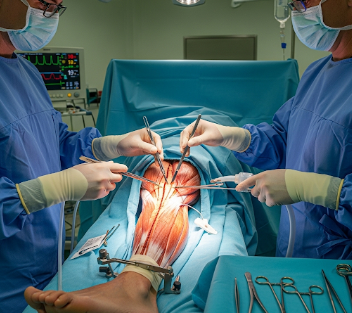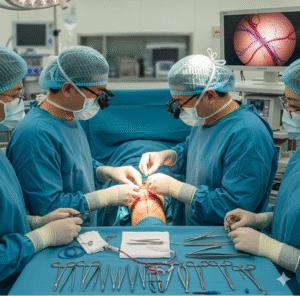Overview
Fasciotomy is a surgical procedure used to relieve pressure within a muscle compartment, often performed to treat compartment syndrome. Compartment syndrome occurs when pressure within the muscles rises to dangerous levels, leading to reduced blood flow and potential nerve or tissue damage. Fasciotomy restores circulation, prevents permanent injury, and preserves limb function.
In South Korea, fasciotomy is performed in advanced orthopedic and trauma centers, utilizing highly precise techniques, sterile environments, and rapid intervention protocols. Korean hospitals emphasize timely treatment, minimal complications, and optimal functional recovery.
What is Fasciotomy?
Fasciotomy involves making surgical incisions in the fascia, the connective tissue surrounding muscle compartments, to relieve pressure.
It is typically recommended for patients who:
- Suffer from acute compartment syndrome → often after trauma, fractures, burns, or crush injuries
- Have chronic compartment syndrome → usually due to repetitive exercise or overuse
- Experience severe swelling, pain, or numbness in a limb
- Require limb-saving intervention
The procedure can be performed in:
- Upper extremities → forearm, hand
- Lower extremities → leg, foot
- Other compartments → depending on the affected region
What are the benefits?
Fasciotomy provides several critical benefits:
- Relieves dangerous pressure → restores blood flow and prevents tissue death
- ➤ Prevents permanent nerve or muscle damage → protects limb function
- ➤ Pain relief → reduces severe discomfort caused by pressure buildup
- ➤ Preserves mobility and strength → allows earlier rehabilitation
- ➤ Life- and limb-saving procedure → especially in traumatic injuries
- ➤ High success and safety in Korea → advanced surgical care reduces complications
Procedure Details
1) How should I prepare for Fasciotomy?
Proper preparation ensures safety and effective outcomes:
- Emergency evaluation → fasciotomy is often urgent; rapid assessment of symptoms and limb viability
- Medical history review → allergies, medications, previous surgeries
- Preoperative imaging → sometimes MRI, ultrasound, or compartment pressure measurement
- Consent discussion → explanation of the procedure, potential risks, and post-operative care
- Anesthesia planning → usually performed under general or regional anesthesia
2) What happens during the procedure Fasciotomy?
The procedure typically takes 30–90 minutes depending on the compartment and severity:
- Anesthesia administration → general or regional
- Incision → surgeon makes a longitudinal cut over the affected compartment
- Fascia release → fascia is carefully opened to relieve pressure
- Inspection of muscles and tissues → assess for tissue damage or necrosis
- Closure or dressing → sometimes the wound is left partially open (delayed closure) to allow further swelling
- Sterile dressing application → protects the wound and allows monitoring
In Korea, fasciotomy is performed with precision, sterile techniques, and advanced surgical instruments, ensuring maximal pressure relief with minimal complications.
3) What happens after Fasciotomy?
- Immediate recovery → patient monitored for vital signs, pain, and circulation
- Pain management → analgesics and anti-inflammatory medications
- Wound care → dressing changes, infection monitoring, sometimes staged closure
- Physical therapy → early mobilization to preserve strength and function
- Follow-up → monitoring for tissue healing, scar management, and rehabilitation progress
Risks / Benefits
Potential Risks:
- Infection at the incision site
- Bleeding or hematoma formation
- Scarring or delayed wound closure
- Nerve injury or persistent weakness (rare)
- Risk of re-elevated compartment pressure
Key Benefits:
- Immediate pressure relief → prevents tissue death and permanent disability
- ➤ Preserves limb function and mobility
- ➤ Pain reduction and faster recovery
- ➤ Life- and limb-saving in emergencies
- ➤ High safety and success rates in Korea → advanced surgical protocols and post-op care
Recovery and Outlook
- Short-term recovery → pain and swelling gradually reduce; wound monitored daily
- Functional improvement → early intervention allows preservation of mobility and strength
- Long-term outcome → with proper rehabilitation, most patients regain near-normal function
- In Korea, patients benefit from state-of-the-art surgical techniques, expert orthopedic surgeons, and structured post-op rehabilitation, ensuring optimal recovery and minimal complications
When To Call the Doctor
Contact your surgeon if you experience:
- Increasing pain, swelling, or redness around the incision
- ➤ Fever or signs of infection
- ➤ Numbness or loss of function in the limb
- ➤ Excessive bleeding or wound discharge
- ➤ Unexpected complications after delayed closure or dressing changes
Timely evaluation ensures safe recovery, infection prevention, and preservation of limb function.
Best Korea Option / Process
South Korea provides world-class fasciotomy services:
- Expert orthopedic and trauma surgeons → skilled in compartment syndrome management
- Advanced surgical instruments and sterile techniques → high precision and safety
- Comprehensive care packages → preoperative evaluation, surgery, and post-op rehabilitation
- Rapid intervention and monitoring → emergency or elective treatment with minimal complications
- International patient support → multilingual staff, appointment scheduling, and personalized care
Patients choosing Korea for fasciotomy can expect rapid, safe, and effective surgical relief of compartment pressure, making it a leading destination for orthopedic trauma care in Asia.













